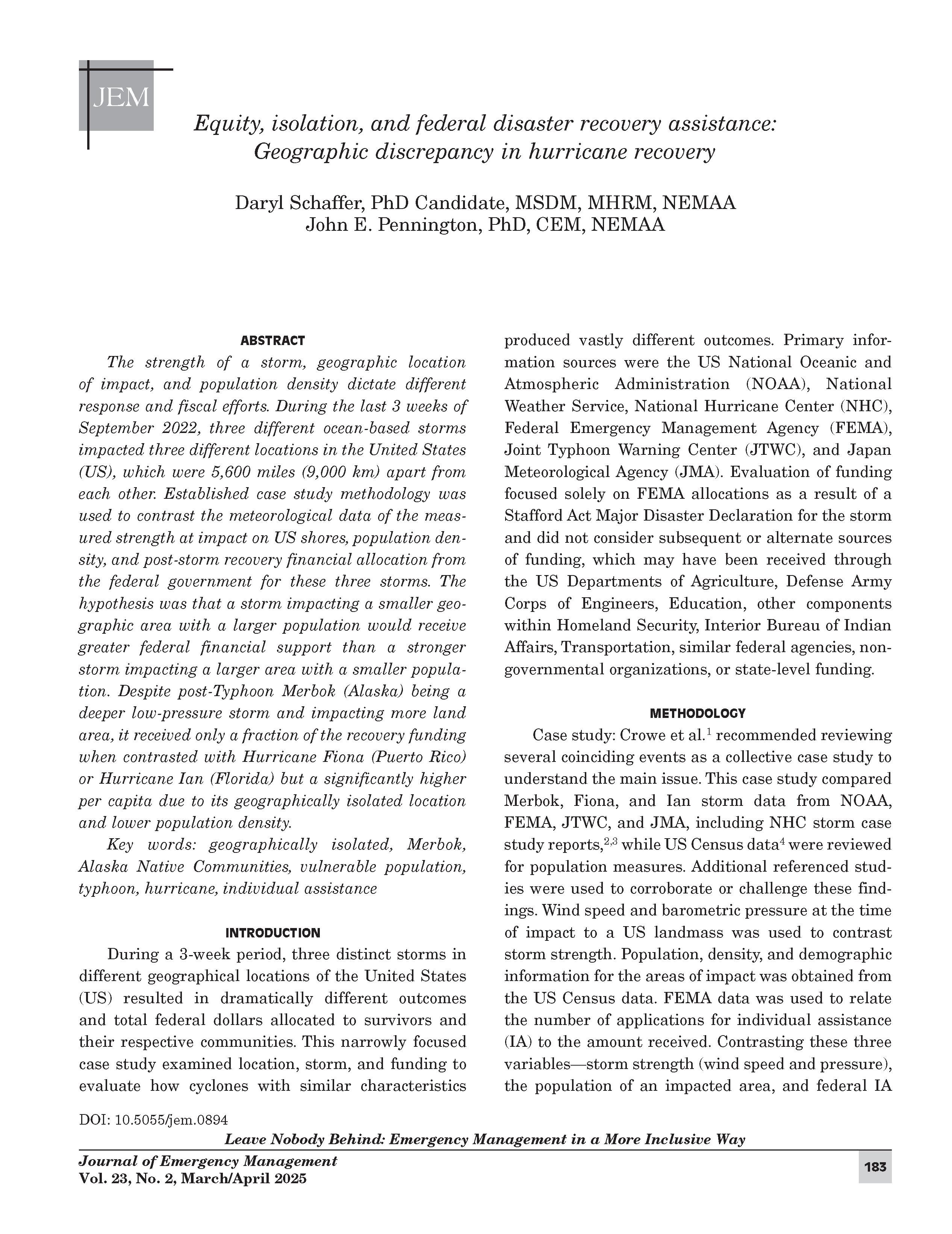Equity, isolation, and federal disaster recovery assistance: Geographic discrepancy in hurricane recovery
DOI:
https://doi.org/10.5055/jem.0894Keywords:
geographically isolated, Merbok, Alaska Native Communities, vulnerable population, typhoon, hurricane, individual assistanceAbstract
The strength of a storm, geographic location of impact, and population density dictate different response and fiscal efforts. During the last 3 weeks of September 2022, three different ocean-based storms impacted three different locations in the United States (US), which were 5,600 miles (9,000 km) apart from each other. Established case study methodology was used to contrast the meteorological data of the measured strength at impact on US shores, population density, and post-storm recovery financial allocation from the federal government for these three storms. The hypothesis was that a storm impacting a smaller geographic area with a larger population would receive greater federal financial support than a stronger storm impacting a larger area with a smaller population. Despite post-Typhoon Merbok (Alaska) being a deeper low-pressure storm and impacting more land area, it received only a fraction of the recovery funding when contrasted with Hurricane Fiona (Puerto Rico) or Hurricane Ian (Florida) but a significantly higher per capita due to its geographically isolated location and lower population density.
References
Crowe S, Cresswell K, Robertson A, et al.: The case study approach. BMC Med Res Methodol. 2011; 11(100). DOI: 10.1186/1471-2288-11-100.
Pasch RJ, Reinhart BJ, Alaka L: National Hurricane Center Tropical Cyclone Report: Hurricane Fiona, AL072022. Washington, DC: National Oceanic and Atmospheric Administration, US Dept. of Commerce, 2023.
Bucci L, Alaka L, Hagen A, et al.: National Hurricane Center Tropical Cyclone Report: Hurricane Ian, AL092022. Washington, DC: National Oceanic and Atmospheric Administration, US Dept. of Commerce, 2023.
US Census Bureau: US Dept. of Commerce: Quick facts. Washington, DC. Available at https://www.census.gov/quickfacts/. Accessed November 8, 2023.
Horn DP: FEMA Hazard Mitigation: A First Step toward Climate Adaptation, CRS R46989. Washington, DC: Congressional Research Service, 2022.
Federal Emergency Management Agency (FEMA): Hazard Mitigation Assistance Program and Policy Guide. Washington, DC: FEMA, 2023.
State of Alaska Dept. of Labor and Workforce Development: Alaska population overview: 2019 estimates. 2020. Available at https://live.laborstats.alaska.gov/pop/estimates/pub/19popover.pdf. Accessed November 12, 2024.
Alaska Native Tribal Health Consortium: The Unmet Needs of Environmentally Threatened Alaska Native Villages; Assessment and Recommendations, Final Report. Anchorage, AK: Alaska Native Tribal Health Consortium, 2024.
Federal Emergency Management Agency (FEMA): FEMA Response and Recovery Climate Change Planning Guidance. 1st ed. Washington, DC: FEMA, 2023.
National Oceanic and Atmospheric Administration (NOAA), US Dept. of Commerce: Beaufort Wind Scale. National Weather Service (NWS). 2021. Available at https://www.weather.gov/pqr/beaufort. Accessed November 12, 2024.
National Oceanic and Atmospheric Administration (NOAA), US Dept. of Commerce: The Saffir-Simpson Hurricane Wind Scale: Updated May 2021. National Weather Service (NWS). 2021. Available at https://www.nhc.noaa.gov/pdf/sshws.pdf. Accessed November 12, 2024.
Singleton F: The Beaufort Scale of winds—Its relevance, and its use by sailors. Weather. 2008; 63(2): 37-41. DOI: 10.1002/wea.153.
National Oceanic and Atmospheric Administration (NOAA), US Dept. of Commerce: Saffir-Simpson Hurricane Wind Scale. National Weather Service (NWS). 2024. Available at https://www.nhc.noaa.gov/aboutsshws.php. Accessed November 12, 2024.
National Oceanic and Atmospheric Administration (NOAA),
US Dept. of Commerce: Minor modifications to Saffir-Simpson Hurricane Wind Scale for the 2012 hurricane season. National Weather Service (NWS). 2012. Available at https://www.nhc.noaa.gov/pdf/sshws_2012rev.pdf. Accessed November 12, 2024.
Miller BI: On the maximum intensity of hurricanes. J Meteor. 1958; 15(2): 184-195.
Howden S, Gilhousen D, Guinasso N, et al.: Hurricane Katrina winds measured by a buoy-mounted sonic anemometer. J Atmos Ocean Technol. 2008; 25(4): 607-616.
Federal Emergency Management Agency (FEMA): Alaska- Severe Storm, Flooding, and Landslides, DR-4672-AK. Washington, DC: FEMA, 2022.
Federal Emergency Management Agency (FEMA): Puerto Rico Hurricane Fiona, DR-4671-PR. Washington, DC: FEMA, 2022.
Federal Emergency Management Agency (FEMA): Florida Hurricane Ian, DR-4673-FL. Washington, DC: FEMA, 2022.
Federal Emergency Management Agency (FEMA): Seminole Tribe of Florida Hurricane Ian, DR-4675. Washington, DC: FEMA.
Federal Emergency Management Agency (FEMA): South Carolina Hurricane Ian, DR-4677-SC. Washington, DC: FEMA, 2022.
Kitamoto A: Digital Typhoon: Typhoon 202213 (MERBOK). Japan: National Institute of Informatics. Available at http://agora.ex.nii.ac.jp/digital-typhoon/summary/wnp/l/202213.html.en. Accessed November 8, 2023.
National Oceanic and Atmospheric Administration: 2022 Typhoon MERBOK (2022254N21160): International best track archive for climate stewardship. Washington, DC: National Oceanic and Atmospheric Administration. Available at https://ncics.org/ibtracs/index.php?name=v04r00-2022254N21160. Accessed November 8, 2023.
Joint Typhoon Warning Center (JTWC), Pearl Harbor, HI, Naval Meteorology and Oceanography Command, Stennis Space Center, US Dept. of Navy: WTPN31 PGTW 102100Z Sep 2022, Subj: Typhoon 15W (Merbok) Warning NR 001. 2022. Available at https://ghostarchive.org/archive/Ev5Vk. Accessed November 12, 2024.
Joint Typhoon Warning Center (JTWC), Pearl Harbor, HI, Naval Meteorology and Oceanography Command, Stennis Space Center, US Dept. of Navy: WTPN21 PGTW 150300Z Sep 2022, Subj: typhoon 15W (Merbok) warning NR 018. 2022. Available at https://ghostarchive.org/archive/Ev5Vk. Accessed November 12, 2024.
Weather MJ: University of Wisconsin Dept. of Atmospheric and Oceanic Sciences. 2022. Available at https://www.youtube.com/watch?v=N4PoxaYko7w&t=2642s. Accessed November 8, 2023.
Dunleavy M: Request for declaration of major disaster for the State of Alaska. Governor, State of Alaska. 2022. Available at https://gov.alaska.gov/governor-mike-dunleavy-requests-federalassistance-for-2022-september-storm/. Accessed November 12, 2024.
State of Alaska: 2022 storms. Available at https://dot.alaska.gov/2022storms/. Accessed November 8, 2023.
Salvano-Dunn D: FEMA’s outreach and recovery assistance to tribes and tribal communities in Alaska, Complaint No. 005539-23-FEMA. Washington, DC: US Dept. of Homeland Security, Office for Civil Rights and Civil Liberties, 2023.

Downloads
Published
How to Cite
Issue
Section
License
Copyright 2007-2025, Weston Medical Publishing, LLC and Journal of Emergency Management. All Rights Reserved.





